Beads are small round or other shaped beads, less than 10 mm in size, which are obtained by melting glass or other materials. They are a variety of decorative materials that used in handicrafts, jewelry and model making.
Classification by materials of manufacture
Manufacturers produce a huge variety of beads, differing in the material from which they are made. This determines the characteristics of the beads, such as strength, color, shine.
Glass beads
Glass beads are small beads made of glass. They are one of the most popular types due to their variety of shapes, colors, and textures.
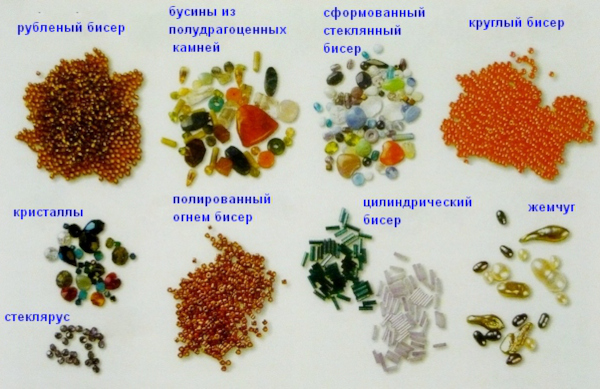
Glass beads are generally opaque, but some types may have transparency or shine. They are used to create a variety of crafts, including jewelry, decorative items, and accessories.
Metal
Characterized by the use of various metal alloys for production. Beads often have a silver, gold or copper hue. Usually used as a decorative element for clothing or in jewelry. The use of a special coating helps protect beads from oxidation.
Acrylic
It is a synthetic imitation of glass. Lightweight and inexpensive acrylic offers a wide range of colors. Production is based on the extrusion of thermoplastics, and the composition of the mass is melted in the desired shape and cooled. Acrylic beads are often used in children's kits for handicrafts and decorating various products.
Wooden
Various types of wood are used in manufacturing. Wooden beads are traditionally hand-cut. To increase strength and improve appearance, they are treated with oil, wax and paint. The variety of shapes and sizes, availability of material contribute to the demand for wooden beads in creativity and decor.
Natural
This includes beads of natural origin. They can be made from shells, plant seeds or nuts. Depending on the material, the product can have a sandy or rainbow color. Although natural multi-colored beads are rare, they are highly valued for their exclusivity and natural origin.
Depending on color and transparency
Spraying is applied to beads – this is the process of creating a thin and shiny coating on the surface, reflecting light and giving it an unusual and attractive appearance. Various spraying technologies are used, such as galvanization, vacuum spraying or polymer spraying.
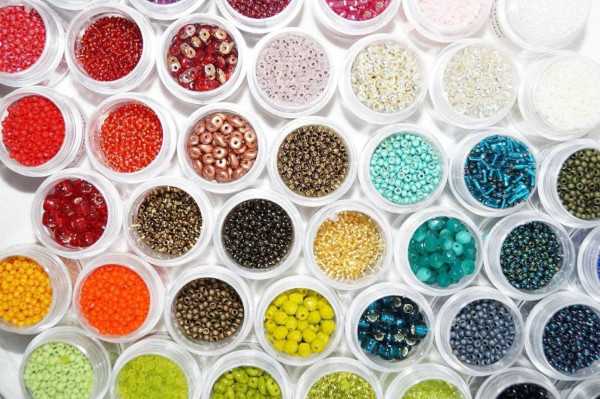
Beads are available in different colors, which are obtained thanks to the pigments in the material. Coloring options reach 1500 shades. Colors from different manufacturers do not match and are actually unique.
By color
| Types of beads | Brief description |
| Plain | A variety that can be dyed any color desired. This occurs during the production of the glass, not after it has been crushed, which allows for beads with uniform coloring. |
| Rainbow | Shimmering with different colors, it creates an interesting effect and is used for decorative purposes. |
| "Chameleon" | This is a type with a color-changing effect. This property is achieved by using several layers of glass of different colors inside the bead or by a special coating on the surface of the bead. The color change can occur under the influence of light or temperature. |
| "Northern lights" | This is a variety with an iridescent rainbow effect. It is achieved by using multi-layered glass with various additives, which allows the beads to reflect light and create colorful shades. |
| Petrol | This is a special type of bead that reflects light, simulating the effect of gasoline stains on water. Often used in jewelry and clothing design. |
| Galvanized | It is distinguished by the presence of a metallic coating that is applied to the surface of the beads. This coating gives the beads a special shine and protection from external influences. This is a material that is used in handicrafts to create attractive and bright products. |
| With pearl coating | It has a shine and a delicate or pronounced white or pinkish tint. This type is ideal for creating sophisticated and romantic images. |
| Under the gilding | It has a coating that imitates the color and shine of gold. It is used to create decorative elements, including interior decoration and the creation of unique clothing items. |
| With mother-of-pearl coating | It has a translucent coating that gives it a soft pearlescent sheen. This material is used in various projects related to handicrafts and creativity. |
| With silver plated holes | The coating is applied to the holes, creating a sparkling effect around them. It is often used to create three-dimensional and eye-catching patterns. |

Beads, the types of which include unpolished, that is, without a coating, retain a rough surface, which gives a special charm to products. The unique relief and texture make it suitable for different styles and trends.
By transparency
Transparency of beads is a property of the material that determines the ability to transmit light. This property affects the appearance and application.

| Types of beads | Brief description |
| Transparent | Initially it has no coating. Due to its transparency it allows to create thin and light decorative elements, it is actively used for embroidery. |
| Translucent | Allows you to create products with interesting visual effects when light passes through the material, creating a play of shades and colors. |
| Opaque | It is used in cases where it is necessary to create dense, color-saturated patterns. |
By brightness of the coating
The differences between matte and glossy bead surfaces are not only in the visual effects. Material with a glossy coating usually has a brighter and more saturated color, while matte is muted and calm. The degree of shine and the amount of light reflected by the surface can also differ.
Glossy
Reflects light, making the product more visually attractive. It can be small, as an added accent, or form the main part of the composition.
Matte
It is of particular interest to lovers of laconic designs, and also symbolizes nobility and restraint.
Silk
Silk symbolizes delicacy and elegance, so these beads are an excellent choice for creating light and sophisticated items.
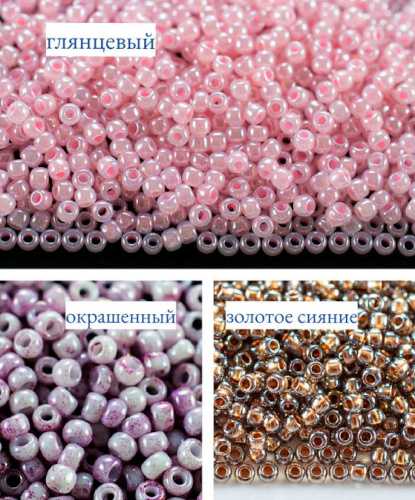
It is usually opaque and has muted colors such as:
- beige;
- brown;
- gray and others.
By form
Beads, the types of which differ in shape, can be classified as round, rectangular and other options.
Round (rocal)
It is a ball with a smooth or textured surface. It is used to create jewelry, decorate clothing and interior items, and for handicrafts.
Glass beads
These are long and thin beads that are used to create decorative elements. They can be transparent or multi-colored.
Chopping
This look is achieved by cutting glass or other tubes into short pieces. Chopping allows you to create spectacular patterns and ornaments, adding volume and texture.
Cylindrical
It has a cylindrical shape and can be either short or long. This type of bead is especially popular in embroidery and jewelry making.
Cubic
It has a crystalline form and is an alternative to regular round beads. It creates an interesting visual effect and is actively used in handicrafts.
Triangular
It is distinguished by its triangular shape and is used to create complex geometric patterns. This is a rare type of bead that requires professional skills to work with.
Hexagonal (Bohemian)
It has an angular shape with 6 edges. Often such beads are used for weaving nets and complex patterns, as well as creating three-dimensional figures.
Figured
It is presented in a wide variety of shapes, from hearts and stars to abstract geometric figures. Due to its expressiveness, it is used to create original designs and accents.
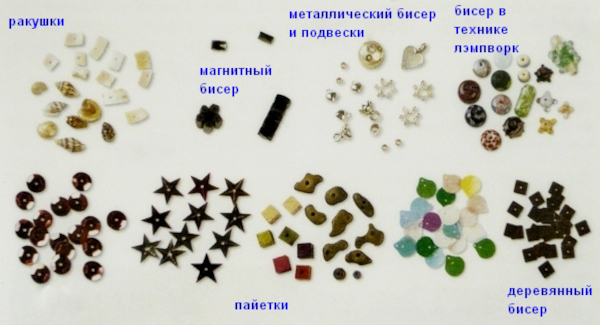
It can be in the form of:
| Bead shape | Brief description |
| In the shape of a butterfly | It has symmetrical wings on a translucent base. This type of beads is used in the creation of miniature products or in decorating various surfaces. |
| In the form of a beveled petal | Used in jewelry making and decorative work, the beveled petal is made by cutting off the corner of one side of the bead, giving the product an asymmetrical yet balanced look. |
| Drops | It has a teardrop shape and is commonly used to make beads, necklaces and other jewelry. Its smooth surface allows for easy matching of beads without losing its shine and transparency. The hole in this bead is not in the middle, but closer to the edge. |
| Farfalle | Refers to shapes with an elongated body that tapers towards the end. Due to this shape, Farfalle is convenient to use as a basis for clear contours and drawings. |
| Twin | It has a flatter shape than Farfalle, making it a good choice for flatter pieces or projects that require a large number of beads. |
| Tila | This shape is suitable for creating clear and precise designs, such as mosaic patterns. In addition, thanks to the relatively flat base, Tila is convenient for working in various handicraft techniques. It has 2 holes for the needle. |
By shape and number of holes
Beads are classified by 2 more criteria: the shape of the hole and their number. These characteristics affect the method of fastening that will be used in the manufacture of various decorations and products. The shape of the hole is also important, as it can affect the strength of the fastening and the appearance of the product as a whole.
With 1 or 2 holes
| Number of holes | Brief description |
| 1 | Easier to use, but may require additional materials for attachment. Round bead with 1 through hole - the basic type of bead. Can be made from different materials. The most common is glass beads. |
| 2 | One of the holes is through, and the other is blind or also through. This solution allows you to thread the thread through 1 hole, secure it with a knot, and then pass the thread through the 2nd hole and form a loop from it. A double hole is used so that the beads do not slide along the thread and create beautiful patterns in embroidery. |
With round, rectangular, square hole
| Hole shape | Brief description |
| Round | For a strong connection with the thread, the round bead has a special edging of the hole. It is preferred to use it for independent creativity: making baubles, bracelets, etc. |
| Rectangular | Most often it is made of opaque plastic or glass. It is in demand by craftsmen for creating appliques or embroidery of complex compositions. It is characterized by strength and durability. It is used to create jewelry, embroidery or decor. It can be used for complex decorative projects. |
| Square | It is made mainly of transparent plastic and is used for embroidering various pictures or panels, creating jewelry. Many types of this bead have a strong core, which gives the beads shape and resistance to damage, making it suitable for complex projects. With its help, you can emphasize the contours of the product or add bright accents. |
By size
Beads, the types of which differ in size, in a larger version can give jewelry a spectacular look, while small ones will allow you to create more detailed and delicate works. The size of beads is not standardized and can vary significantly even among manufacturers in the same country.
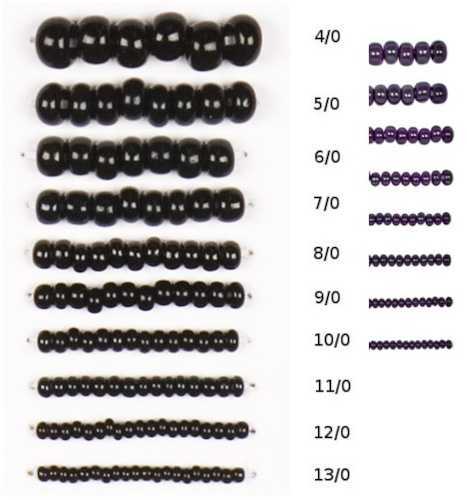
Manufacturers distinguish different categories, choosing, for example, the metric or American measurement system. In the metric system, one of the most popular bead sizes is "10/0" (diameter from 2.3 to 2.5 mm).
There are also beads of size "11/0", slightly larger - about 2.6 mm. It is used to create thin and painstaking products.
| No. | Bead diameter, mm | Possible deviation of diameter, mm | Hole diameter, mm | Quantity in 50 g |
| 1/0 | 6.6 | 6.3-6.8 | 2.00 | 190 |
| 2/0 | 6.1 | 5.8-6.3 | 1.60 | 240 |
| 3/0 | 5.6 | 5.3-5.8 | 1.40 | 265 |
| 4/0 | 5.1 | 4.8-5.3 | 1.30 | 370 |
| 5/0 | 4.6 | 4.3-4.8 | 1.20 | 605 |
| 6/0 | 4.1 | 3.7-4.3 | 1.10 | 665 |
| 7/0 | 3.5 | 3.2-3.7 | 1.00 | 1055 |
| 8/0 | 2.9 | 2.8-3.2 | 0.90 | 2100 |
| 9/0 | 2.6 | 2.4-2.8 | 0.90 | 3400 |
| 10/0 | 2.3 | 2.2-2.4 | 0.80 | 4550 |
| 11/0 | 2.1 | 2.0-2.2 | 0.70 | 6500 |
| 12/0 | 1.9 | 1.8-2.0 | 0.60 | 8250 |
| 13/0 | 1.7 | 1.6-1.8 | 0.50 | 14550 |
| 14/0 | 1.6 | 1.5-1.6 | 0.40 | 16250 |
| 15/0 | 1.5 | 1.4-1.5 | 0.40 | 31250 |
CROW-BEADS (very large)
One of the largest types of beads from 6/o and smaller is called CROW-BEADS. It has a large diameter from 3.7 to 6.8 mm and is usually used to create bright and noticeable jewelry. Suitable for those who prefer larger elements in their products.

Beads with a size of 6/o add a visual accent and become the center of attention. They can be used to create chic rings, large bracelets and original pendants.
E-BEADS (large)
Another large type of beads is called E-BEADS. It is slightly smaller in size than CROW-BEADS, from 8/o to 7/o, but still remains quite large: from 2.8 to 3.7 mm. E-BEADS are often used to create jewelry such as bracelets, earrings or necklaces, and add special charm and shine to them.
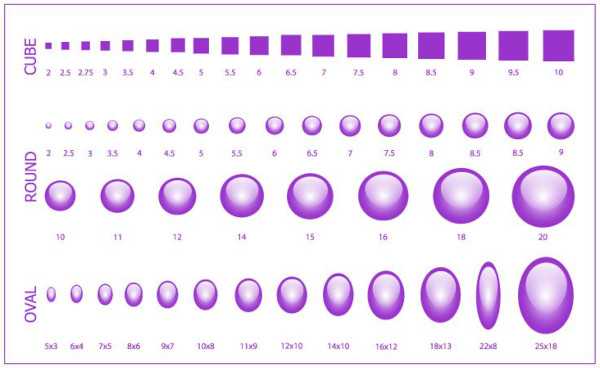
Due to its size, beads with a size of 8/o are perfect for creating voluminous jewelry. It is also often used in women's clothing, complementing and decorating outfits.
PONY-BEADS (medium)
It is a medium-sized bead with a size from 10/o to 9/o. It has universal characteristics and can be used for all sorts of creative ideas. These are beads with a diameter of 2.2 to 2.8 mm, which are suitable for creating bracelets, necklaces and other types of jewelry.
The 10/o size seed bead is popular for jewelry making and is suitable for creating dense and structured patterns that require more detail. Due to its medium size, it can be used both on its own and in combination with larger seed beads.
SEED-BEADS (small)
The smallest type of beads from 11/o and more are SEED-BEADS. It has a small diameter of 1.4 to 2.8 mm and a fine structure, which makes it ideal for details and embroidery on textiles. SEED-BEADS can be used in various handicraft techniques, such as bead embroidery or creating miniature jewelry.

The smallest beads with a size of 15/o are suitable for creating small and thin patterns, for embroidery or bead knitting. This size is most often used for making bead bracelets and necklaces, making jewelry delicate and graceful.
By manufacturers
The countries that produce beads are important in terms of the characteristics of these products. Each brand has its own characteristics, different colors, shapes and materials.
Japanese
Beads, the types of which depend on technology, produced in Japan are considered to be among the best in the world. This is a high-quality product made of glass, metal and plastic. Japanese beads are valued for their bright shine and variety of color solutions. It is used in the production of jewelry, bijouterie and embroidery.
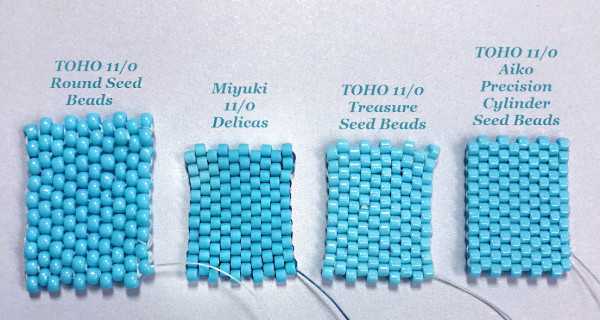
Products made from Japanese beads do not fade over time and retain their original appearance for a long time. A major supplier of beads is the Japanese manufacturer "Toho". The company specializes in the production of oval and cylindrical beads, as well as beads of various colors and shapes.
Czech
One of the world's leading suppliers of quality beads is the Czech Republic, famous for its glass products with a smooth coating. The traditional manufacturer of Czech beads for over 100 years is the company "Preciosa". The company offers crystal beads, which can be an alternative to glass.
Chinese
Chinese beads also stand out. Plastic beads are often produced there. It differs from other types by its low price, which makes it accessible to a wide range of craftsmen. Among the famous Chinese manufacturers, one can note the company "QIAOQIAN", which also offers a wide range of colors and sizes.
Turkish
These are usually small round glass beads. They are usually used for embroidery, handicrafts, and jewelry making. Turkish beads are durable, bright, and come in a variety of colors and sizes. They are also often used to create mosaics and other decorative elements.
Indian
It can be any color: from bright red to transparent. It is created mainly from glass, and then painted in various ways, including manual hot painting. It is used both for decorative purposes and in handicrafts. It can be of different shapes, but most often it is round. One of the most ancient types of beads.
Italian
Consists of a glass core surrounded by colored layers. It is characterized by a high degree of transparency. It is usually used in handicrafts: for making beads, bracelets, embroidery. It is also suitable for decorating various products. It can have a matte or glossy surface.
American
Beads of the "American" type have a smooth, shiny surface and are made of glass with the addition of various metals (usually copper and aluminum), which gives them a bright color and shine.

The quality of American beads is above average, making them a popular choice for those who value quality materials. However, the cost may vary depending on the brand, caliber, and characteristics of the beads.
It is important to find a balance between quality, cost and appearance of beaded items.
Known types of beads can vary in shape, size and many other parameters. The most common are round glass beads. Some types can have a special shape, such as stars, hearts or leaves, which allows you to create unique and original jewelry.
Video about beads
Overview of types of beads and their differences:
